|
by Ron Steiner
By the end of World War II, I had acquired a large number of Bergen Toy & Novelty Co. figures but was completely unaware that Beton had also produced accessories and playsets to go with these figures. I had never seen any type of Beton set at our local F. W. Woolworth Five and Dime store, and my guess is that the company didn't have as extensive a distribution system on the West Coast as they had in the East. Of course, as kids, this didn't bother us in the least, we went right on building our own forts out of twigs, Popsicle sticks, and Lincoln Logs until the first rains washed them away.
Pre-World War II Playsets
One of the first things I did when I began collecting toy soldiers in 1985 was to buy every book I could find on the subject. I soon discovered, and thoroughly devoured, all of Richard O'Brien's toy books. Although my favorite Betons were listed in his 1985 book Collecting Toys, 4th Edition, there was no indication that boxed sets or accessories existed. I was thrilled to discover Richard's The Second Catalog Book in 1986, which showed two catalogues from Beton's Carlstadt, New Jersey, location that dated back to the late 1930s or very early 1940s. The first listed and illustrated all of the Beton figures on early oval bases, but the second catalogue completely blew me away with its listing of Beton accessories and playsets. The accessories page showed a Trench that had the option of being covered with sand or grass, a sand-covered Bridge, a knock-down-type Ranch Fence, and a 12-inch Flagpole with Flag and Halyard -- all made of sturdy cardboard. The first playset illustrated was an Indian Stockade Village. The items included in the sets could also be purchased separately.
Indian Stockade Village, Set #4001

This Stockade Village, which I recently acquired from Ponylope, originally belonged to Don Pielin. The set consists of two #3002 Small Towers that would have been used at the corners of the matching fence sections but were not listed in the second Beton catalogue. Those listed include the #3003 Tower (missing the stairs plus a couple of parapets on my piece), #3005 Hut, two #3006 Tepees, #3007 Well, and #3019 Indian Lodge. All of these pieces are grass covered. All had "Schuster's Milwaukee" price tags that showed that the large Tower and Lodge sold for 20 cents and the others for 10 cents each. I've yet to acquire three pieces that will complete my set. These are listed in the catalogue as #3000 Fence Section (six needed), #3009 Tree (two needed), and a 19-inch by 29-inch base. The Village set in the catalogue also included a dozen assorted Indians.
There are two other playsets illustrated in this catalogue. Set #4002 Military Encampment consists of a Base, four Machine Gun Towers, five Straight Sections (walls), a Field Hospital (which appears to be the same Indian Lodge with a "Hospital" sign), six Pup Tents, and the Flagpole, plus two Trees from the Accessories page and a dozen assorted soldiers. Set #4003 Cowboy Ranch consists of a Barn and a Bunkhouse, 12 Fence Sections, and four Trees, plus the Flagpole from the accessories page, a Tripod and Kettle, a Base, six horses with riders, and five assorted cowboys. On the last page of this catalogue it made mention of "more than half a hundred different numbers" of boxed sets.
Pre-World War II Boxed Sets
The last page of the second Beton catalogue in O’Brien’s 1986 The Second Catalog Book illustrated some of the earliest boxed sets produced by Bergen Toy & Novelty Co. The cover of the first set shows a stagecoach and cowboy outriders being attacked by Indians. Below that is a smaller box that could be a wholesale shipping box showing a covered wagon with cowboys and Indians on one side. To the right is an identical box with soldiers on the side. These three boxes are simply titled “Beton Toys.” The fourth illustration is a box titled “Parade of Beton Toys” that shows marching and mounted soldiers, plus a cannon on the box cover. At the bottom of the page is an illustration of a train titled “Beton Toy Streamliner." Speculation is that this could have been the box/play accessory for Beton’s railroad figures. To my knowledge, the only boxes that have turned up in collections are the Parade of Beton Toys boxes containing military figures. Because of the rarity, these boxes were probably not produced beyond the very early 1940s.
Parade of Beton Toys, Set #100
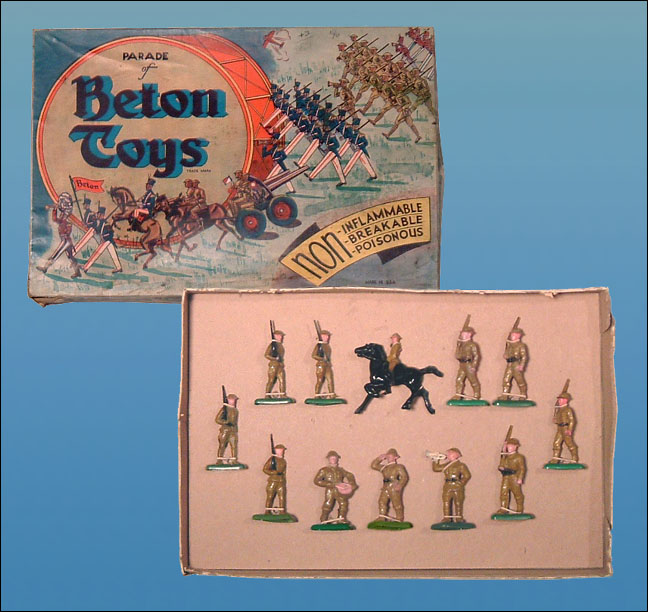
Set #100 poses a bit of a description problem. The earliest reference is in a 1938 Beton catalogue that lists this set simply as U.S. Infantry. Richard O’Brien’s 1997 Collecting American-Made Toy Soldiers book lists it as Unity Fortress Infantry Marching, based on a Beton catalogue circa 1939-1940. I believe that the 1938 catalogue is a carryover from when Bergen produced their line in metal using Metal Cast’s molds, because most of the descriptions mirror Metal Cast’s descriptions. Since Bergen produced only #510 Rifleman Marching at that time, I’ve come to the conclusion that Set #100 thereafter contained only marching military figures. When the full line of military figures was produced, a soldier assortment was packaged in the Parade box under catalogue #121.
When I acquired this Parade of Beton Toys set #100 box, it was empty and did not include the insert for attaching soldiers. I followed the layout of my Parade Set #121, created an insert, then used my own imagination as to what marching soldiers the box might have originally contained.
Parade of Beton Toys, Set #121
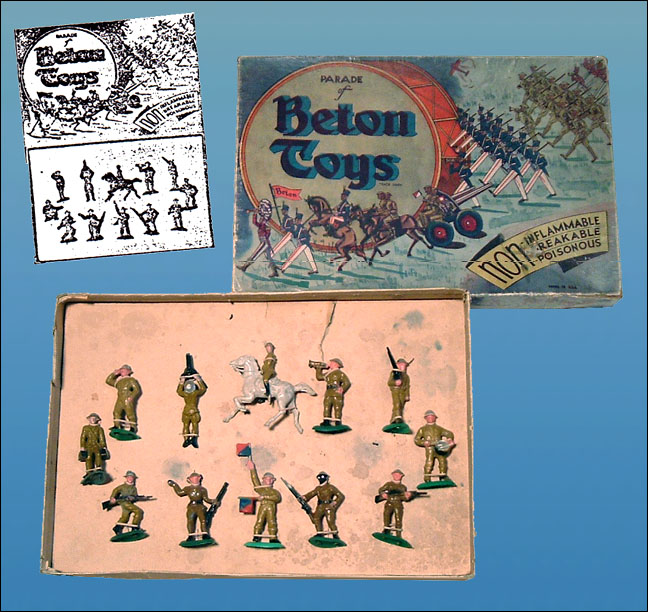
When I received it, this Parade Set contained a mix of three early oval-based and five rectangular-based soldiers, along with four small military riders. Most did not seem to match, so I’ve concluded that some youngster must have used the box to store his army of later Beton acquisitions. The box did contain the original insert, but I had no idea as to which end was up. When I told Richard O’Brien about my find, he was kind enough to send me a copy of a very small June 1941 Playthings magazine illustration showing how this set was originally outfitted. I’ve included this illustration in my photo.
Display Box Sets
The longest running display boxes used by Bergen Toy & Novelty Co. are those shown below. The two Indian sets in my collection date back to the late 1930s or very early 1940s, based on the earlier type Broncos, the thinly cast bows, and the painting of the figures. These earlier boxes were not numbered, and separate box inserts were used for the different assortments of figures. This box continued in use well into the 1950s.
Indians, Assorted (foot and mounted), probably Set #118
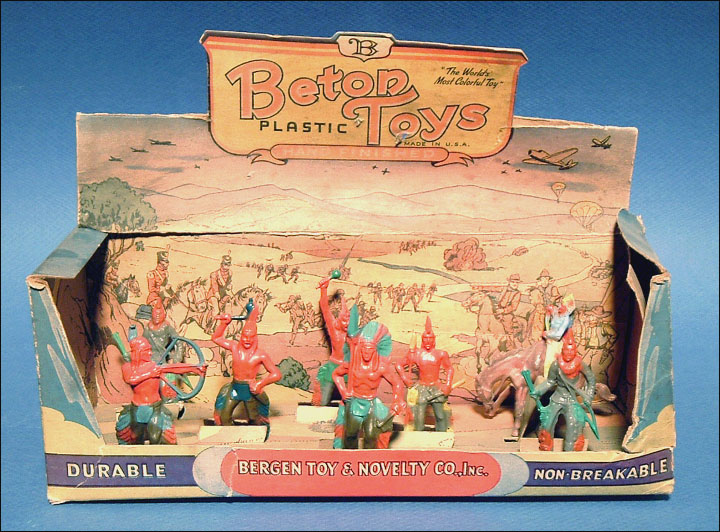
Mounted Indians Bronco Horse, probably Set #M213
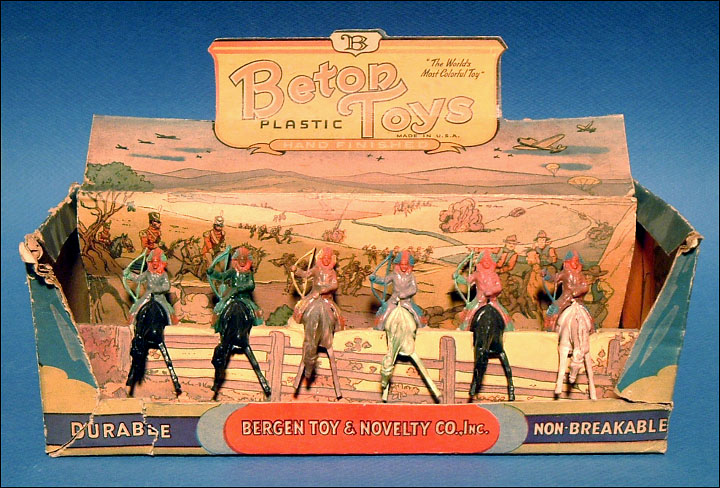
Early World War II Era Playsets
When Richard O'Brien's first Collecting Toy Soldiers book was published in 1988, he listed all of the Beton accessories and sets. I was surprised by the number -- more than 60 sets were included. Some of these turned out to be boxed playsets, and, of course, I immediately set out to find some of them. When Richard's second edition of Collecting Toy Soldiers came out in 1992, he had reproduced a 1942-1943 N. Shure catalog that showed Beton playsets. These sets had an outer boxed sleeve with a 20-inch by 5-inch by 3-1/2-inch inner cardboard box that represented Forts, Ranches, and Indian Lodges. So far I've been able to acquire one set of each style, with the exception of the Ranch. The sets included either 13 or nine figures, and the wholesale price was $10.80 per dozen for the set of 13, and $8.25 for a dozen sets of nine. Each fort included a floor insert that had diecast tabs for attaching seven standing figures, plus holes for the attachment of a horse and rider with a rubber band. I've not yet found a floor insert that could accommodate 13 figures. Of my four sets, none of the tabs had ever been used, indicating that the figures were not attached to the floor at the factory. The sets must have been sold with the figures in a bag or loose in the box. It should be noted that these sets were sold during the war, and most of them turn up with unpainted figures. In my photos below, I've taken artistic liberties and added more colorfully painted figures.
Fort Beton, Set #100
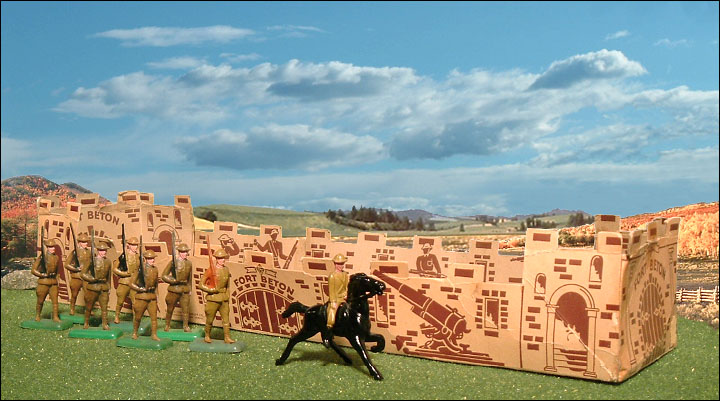
A recent acquisition, this fort had lost all of its original figures. Bergen Toy & Novelty Co. listed this catalogue number as Unity Fortress Infantry Marching, so I've pictured it with seven of Beton's original #510 Rifleman, Marching Position, figures, plus a horse and rider. There is no reference to Unity Fortress on the outer sleeve or the fort itself. A copyright date of 1941 is printed on the side of the fort.
Beton Cadets Fort, Set #101
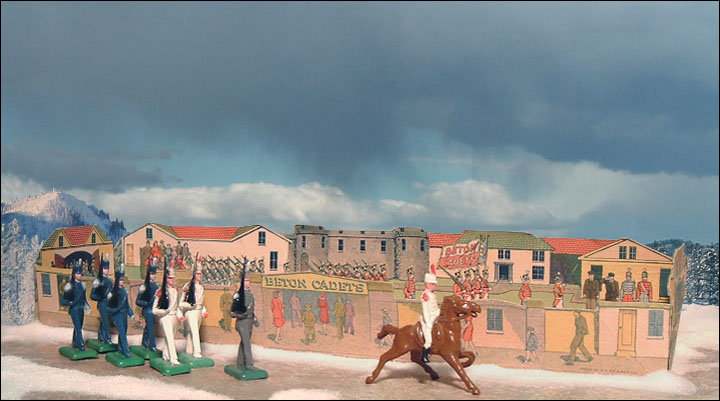
I acquired this Cadets Fort in 2001, but it also came without any figures. The 1942-1943 N. Shure catalog lists only a 13-piece cadet set, but the floor insert in my set allows for only nine figures. I suppose it's possible that the one insert sufficed for both sizes of sets, since the figures were probably just loose in the box anyway. In any event, I've shown a nine-piece set that includes seven standing cadets along with the horse and rider in my photo. There is a $1.00 price tag still attached to the end of the fort.
Beton Lodge, possibly Set #118

When I acquired this set in 2006, it contained four #726 Indian Leaders, two #729 Indian Chiefs, a #730 Indian Warrior, and a #M411 Indian, Mounted on Bronco, all unpainted. I've put a better assortment of Indians in this photo, which encompasses the full line of Beton Indians. The outer box had "#481258" stamped on the end, but I suspect this was the retailer's number, not a Bergen catalogue number. I believe the only Beton catalogue number that could apply to this set would be #118, based on the assumption that these numbers carried over from prewar Beton Toys boxed sets.
Fort Beton, possibly Set #121
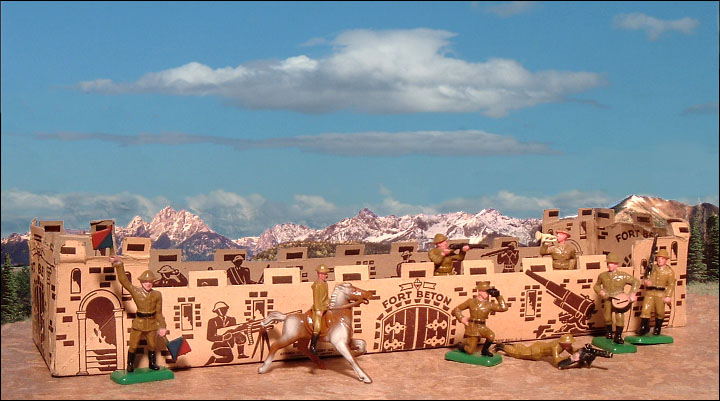
This was the first fort that I acquired in 2001, and it has the same problem of an unlikely catalogue number. The "1254" stamped on the outer sleeve is also probably a retailer's number. I suspect that this should be an earlier version of Set #121, also carried over from the earlier Parade of Beton Toys boxed set. My set included nine unpainted standing soldiers, two #501 Machine Gunners, a #508 Bugler, #511 Infantryman with Field Glasses, #514 Signaller, two #515 Infantry, Charging, and two #517 Machine Gunners, Kneeling. There was no horse and rider included. I've shown the set as I believe it should have been originally outfitted, with seven soldiers plus the horse and rider, based on the floor insert.
Lincoln Logs, Sets #3LTF, #4LTF, and #5LTF
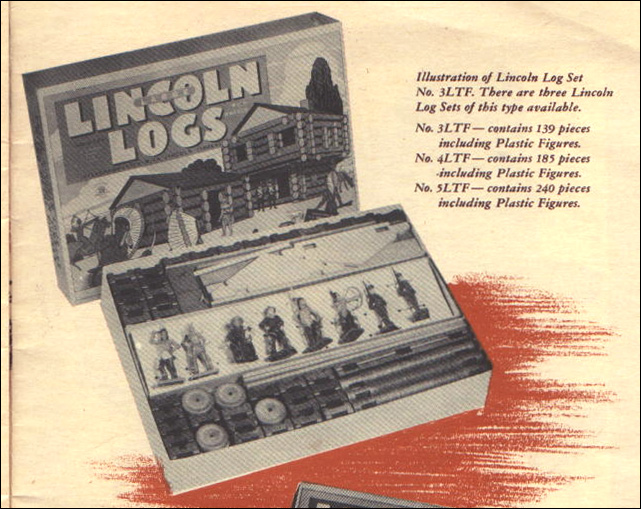
The last playset from the early WWII era that I feel should be represented was not produced by Beton at all. While at the West Coaster show in 2003, I acquired a 1943 Lincoln Logs booklet titled The True Story of the Log Cabin. The last page illustrated a Lincoln Logs set that contained eight Beton figures. Because of the wartime metal shortage, the company evidently contracted with Beton to provide assorted figures for Lincoln Logs sets.
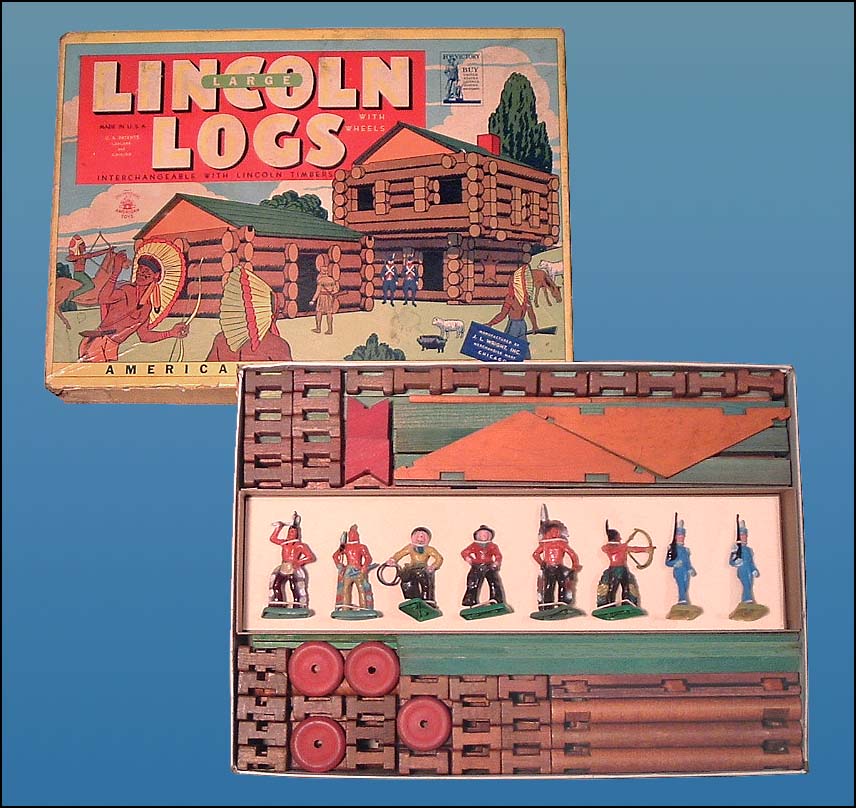
October 2009 Update: I recently acquired the #3LTF Lincoln Logs set pictured above. LTF stands for Logs, Timbers, and Figures, and the timbers are square rather than round as is usually associated with Lincoln Logs. Surprisingly, the set was missing only two timbers, plus one Beton figure. I replaced the two timbers with similar square logs from American Logs by Halsam. Also missing was the cardboard divider and figure mounting tray, but I was able to reproduce these based on a 1944 Lincoln Logs set that I own. In my photo of this set, I’ve arranged the pieces and Beton figures to match the 1943 catalogue page shown above. The two Indians on the left and the two Cadets are original to the set, along with three Indian Chiefs. None of the Chiefs matched well, so I replaced them with a better painted Chief and the two Cowboys that should have been included, plus I’ve added the missing Indian with Drawn Bow. A couple of interesting things that turned up on the box top were the World War II Victory Bond poster, and the original price sticker from Strauss Stores showing a $3.49 retail price for the set.
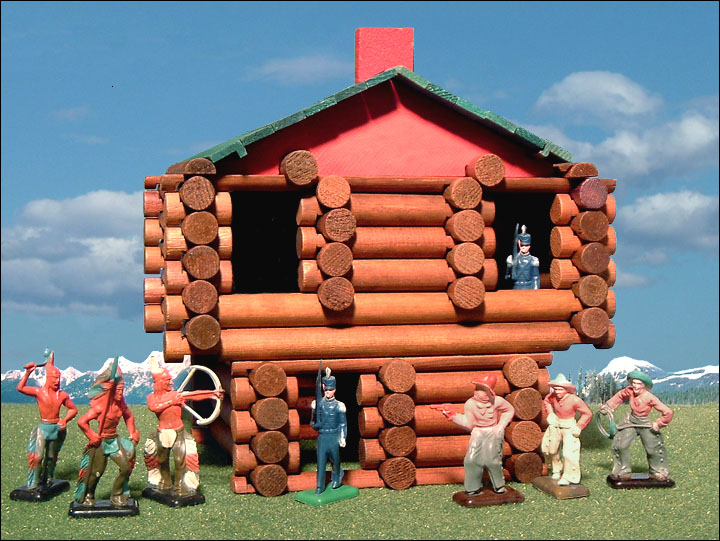
Late World War II and Early Postwar Playsets
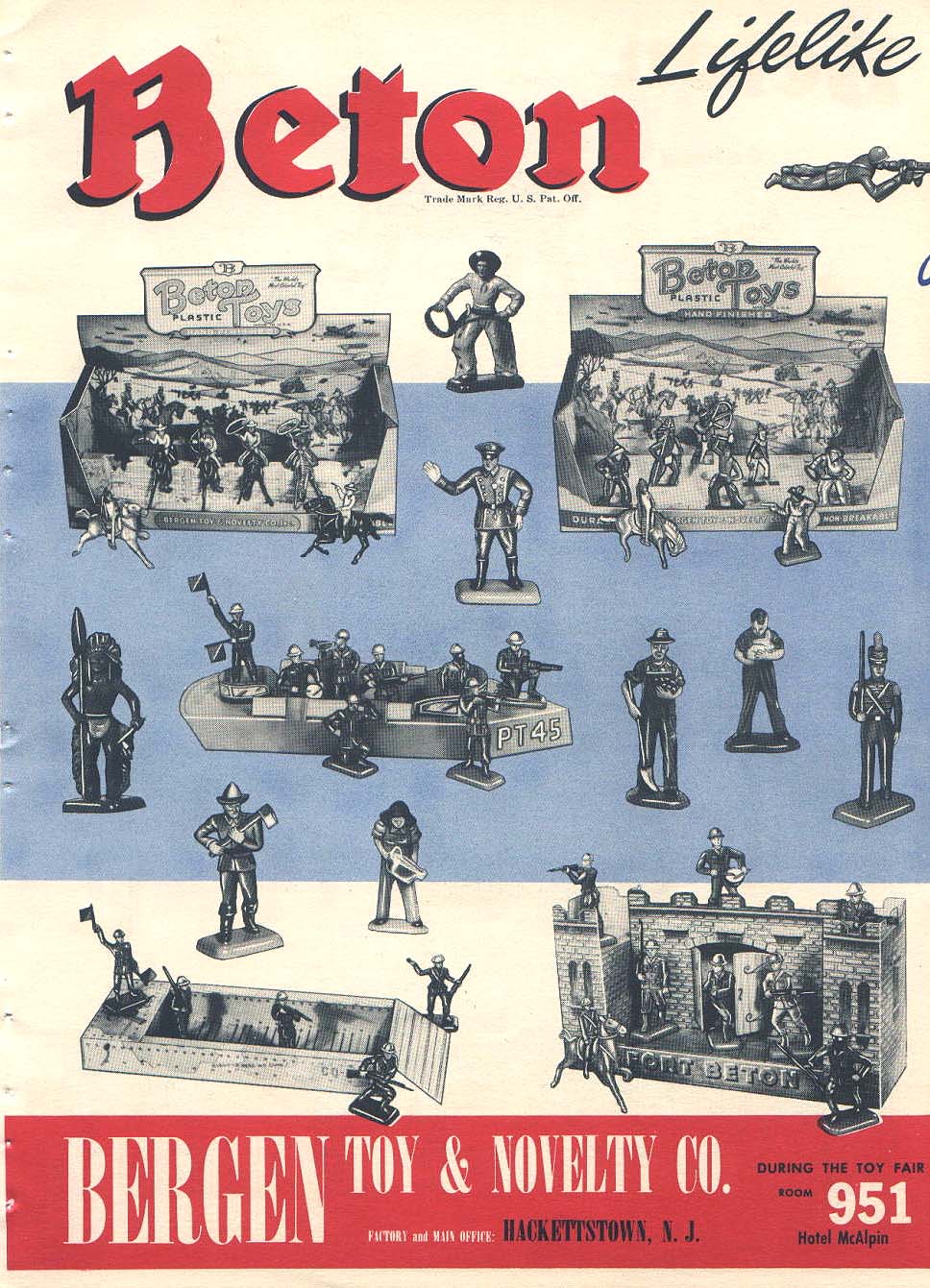
This page is from a Beton advertising insert that was placed in the March 1951 Playthings magazine for the New York Toy Fair. Three of Beton's more creative playsets are shown: a PT Boat, a Landing Barge, and a redesigned Fort Beton. These three sets are also shown as full-page ads in both editions of Richard O'Brien's Collecting Toy Soldiers and probably date from earlier than my 1951 insert. My guess would be around 1945-1946, based on the depicted mix of early rectangular-based WWI soldiers plus the rectangular-based transitional post-WWII soldiers. Update: I recently acquired a Beton ad, shown below, from the March 1946 Playthings magazine that illustrates all three of these playsets. In addition, a subtitle reads “Soldiers now come in World War II Uniforms.”
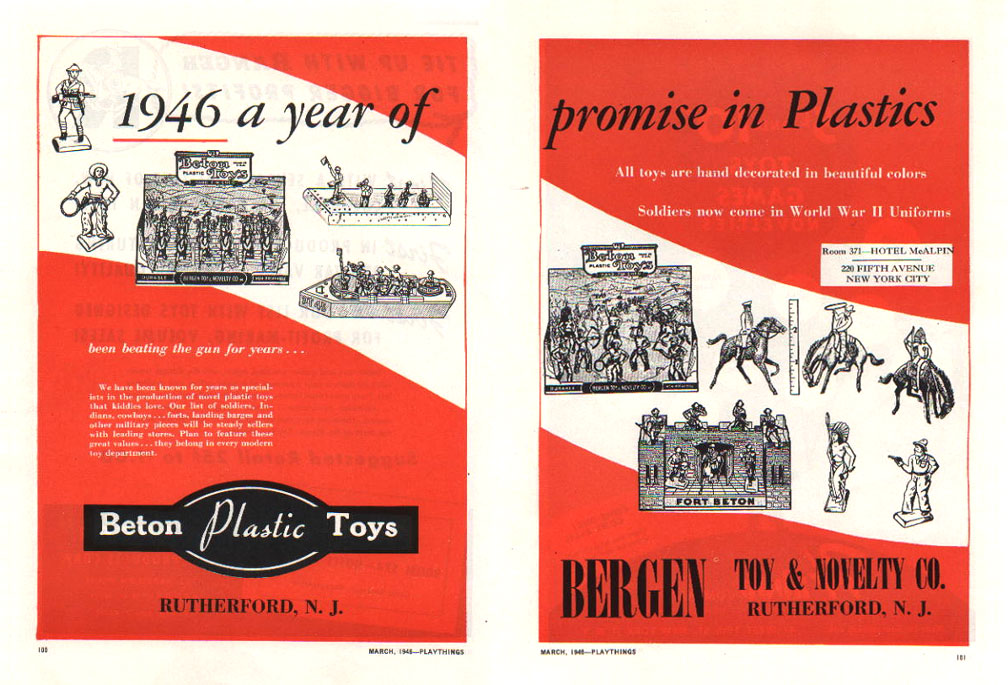
Fort Beton, Set #121
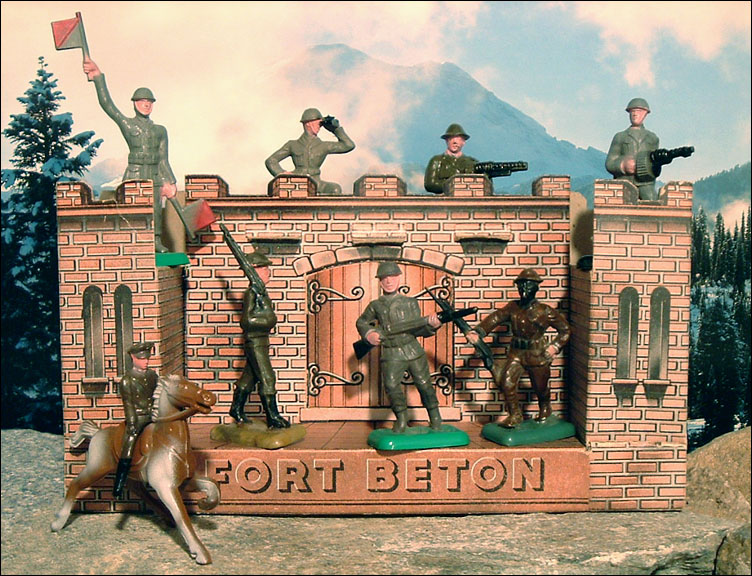
The catalogue number 121 that was assigned to this set is definitely a carryover from the prewar Parade of Beton Toys boxed set described earlier in this article. I’d been eagerly searching for this particular fort for many years and finally acquired it in June 2008, but once again the set came without any figures. I’ve pictured a typical mix of WWI and transition WWII soldiers in the olive drab and dark brown uniforms that were predominant right after the war. The carton itself is the fort, and it included nine figures and retailed at $1.00.
U.S. Rangers Invasion Barge, Set #121A
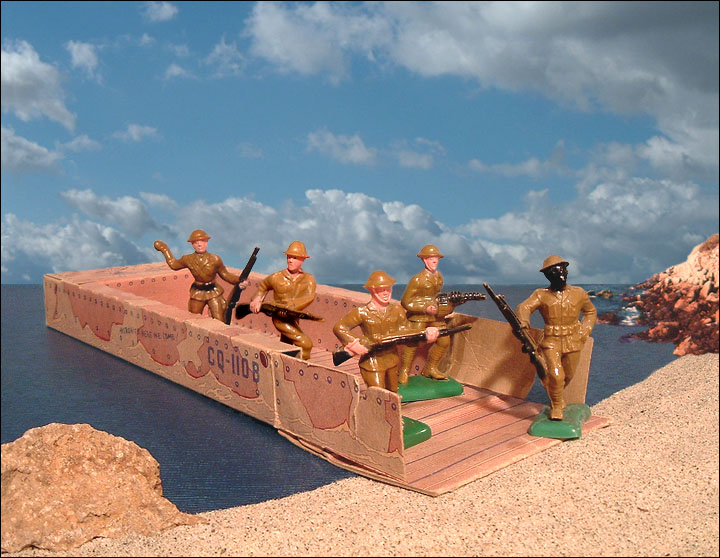
Even though this Landing Barge is depicted in my Playthings insert as having a WWI and WWII mix of soldiers, I've yet to see a set turn up with anything other than unpainted WWI Beton soldiers. My barge came with three soldiers: a #515 Infantryman, Charging, a #516 Drummer, and a #517 Machine Gunner, Kneeling, all in typical 1945-1946 unpainted olive drab. I've replaced them in the photo with an assortment of painted soldiers. This barge came in an open-ended protective sleeve and retailed at 60 cents, but only five soldiers were included.
PT Boat, Set #PT45
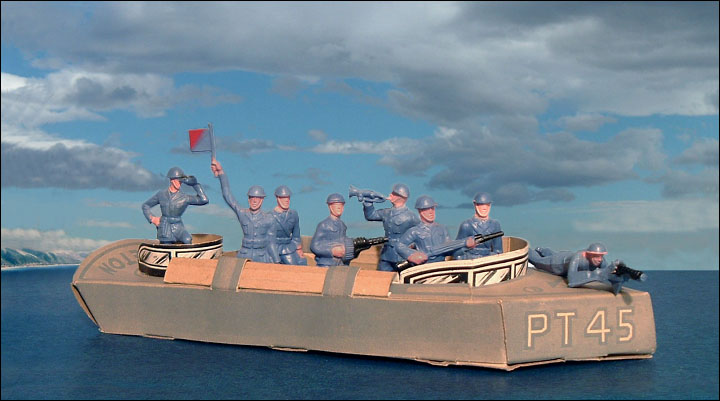
This PT Boat was acquired in 2007, and it came close to containing the proper amount and type of soldiers depicted in the Playthings insert. Only one soldier was missing, but the set included a painted WWI #512 Rifleman, Marching, in khaki, plus six of the WWII transition pieces in an assortment of bright colors with painted details. For my photo, I've replaced them with all blue-uniformed figures. These blue figures are probably the closest that Beton ever came to producing a navy. The PT Boat came inside a box, and possibly some slight assembly was required. The set sold for $1.00 and contained eight soldiers.
Display Box Set, possibly Set #121 or Set #500
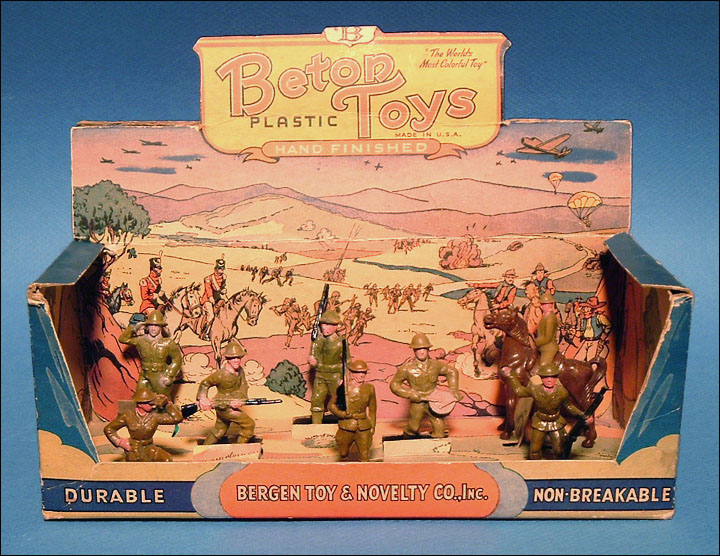
This display box, in my collection, is obviously a newer box with slightly brighter printed colors. Since the figures are all painted, I would date this set at very shortly after World War II, when Beton again began to paint their figures. There’s a problem with the standing horse, which didn’t begin production until March 3, 1950. Since all of the soldiers match and are prewar, I can only assume that a previous owner replaced the horse. This box has no stamped catalogue number. #121 was Bergen’s original number for an assortment of military figures, however by the mid-1940s, that number appears to apply only to Beton Fort sets. Sometime after WWII the assorted soldiers box number changed to #500.
1950s Sets
After the second world war, the interest in Bergen’s military figures began to wane, while railroad figures and cowboys and Indians continued in popularity. Redesigned soldiers with updated WWII uniforms were produced in 1946 and then again beginning in 1949, when Beton’s full line was redesigned and incorporated the new cast-on bases. A new line of farm figures was also introduced in 1949. A few new Cowboy and Indian Small Riders were introduced in 1950, and then an explosion of new Beton Circus figures, in 1951, and Large Riders, in 1952, hit the toy market.
Below is a photo from the Bergen Toy & Novelty Co. Archives showing a J. J. Newberry window display that covers many of Beton’s products, including boxed sets. This photo also appears in a circa-1955 Beton catalogue that encompasses the full line of their products.
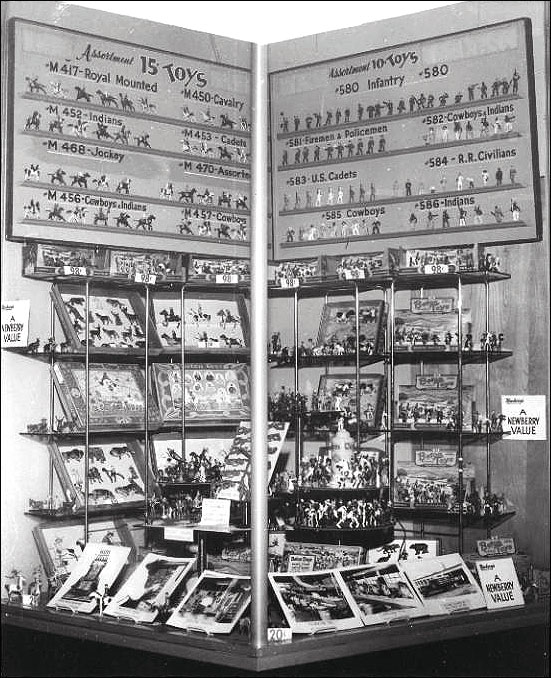
Infantry In Action (foot and mounted), Set #500
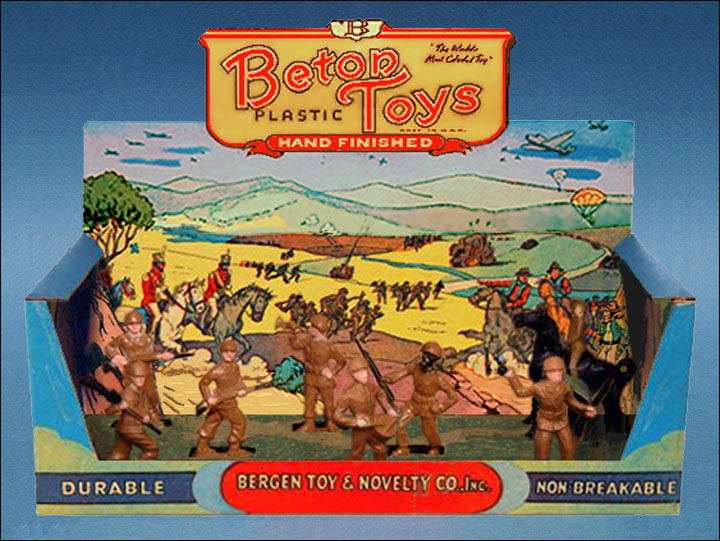
As mentioned earlier, this type of display box continued in use through the 1950s. Nine of these sets are depicted in the top row and right side of the J. J. Newberry photo. The sets shown are: #160 Firemen & Police, #101 U.S. Cadets, #120 Cowboys & Indians, #M-222 Jockeys, #119 Cowboys - Assorted, #M-204 Mounted Cadets - Running Horses, #M-216 Mounted Cowboys - Assorted Horses, #M-214 Mounted Cowboys & Indians - Assorted Horses, and #118 Indians. Included in the 1955 Beton catalogue are illustrations of 12 of these different display box sets. There appear to be two separate inserts used. The first seems to be the same as the earlier 1930s and 1940s inserts, while the second style has a longer, more substantial brace to hold the horse and rider. By the 1950s, the printing of these display boxes had become very colorful.
Circus Playsets
The great majority of the boxed sets that were produced during the 1950s focused on the newly designed pieces that included circus, farm, and larger mounted figures. These all came out in newly designed boxes, but the only items that could be considered true playsets during the ‘50s were three circus related sets. Richard O’Brien pictured them in his 1997 Collecting American-Made Toy Soldiers No. 3. The three photos are from the Beton Archives and include a Beton Circus Tent and two cardboard Circus Wagons. It’s hard to consider these individual wagons to be “sets,” unless they were sold with more animals than the wagons could accommodate. The two archives photos seem to indicate that this was the case.
Tent and Assorted Circus Animals, Set #ZT-151
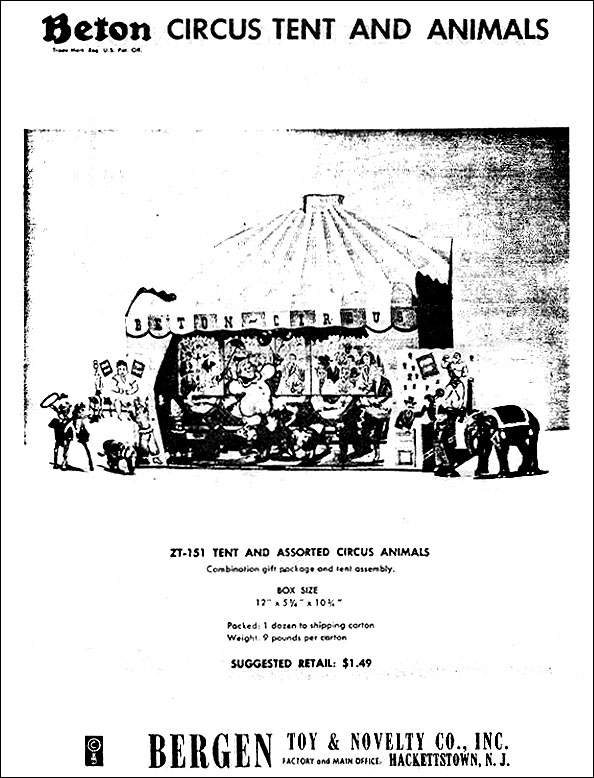
The first circus set in O'Brien's 1997 book is a large, cardboard Beton Circus Tent with printed sideshow posters, ticket seller, and a large audience. The photo shows the following Beton figures included with the set: seven animals, two Clowns, a Trainer, and a small mounted Cowboy with Lasso. I've included a scan of a photocopy of the circa-1955 Beton catalogue that I have that shows an advertisement for this same set. It gives the measurements of the box as 12 inches by 5-1/4 inches by 10-3/4 inches and a suggested retail price of $1.49.
Beton Circus Animal Wagon, Set #ZW-81
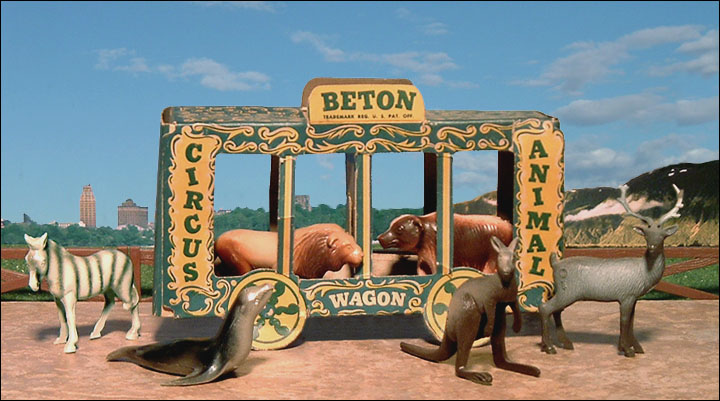
I acquired this version of the Circus Wagon in 2003, and although it should accommodate only two of the Small Circus Animals, there were three included in the purchase. These three were the Bear, Lion, and Kangaroo. I've pictured this set with a larger assortment of six small animals based on the archives photo. The wagon is made of a very thin cardboard, and the bars and wheels tend to collapse. The catalogue number hasn't shown up on a list, but it is printed on the bottom of the wagon. This number follows the wholesale handling box #Z-80 for two dozen assorted Small Circus Animals, as shown in the circa-1955 catalogue.
Beton Circus Animal Wagon, possibly Set #ZW-181
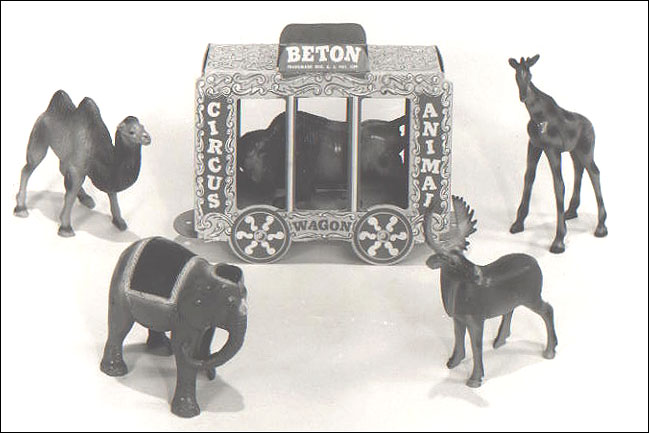
I haven't acquired one of these wagons as yet, but I own this copy of another Beton Archives photo that shows it. This wagon could accommodate only one of the Large Circus Animals, but it could have been sold with an assortment of five large animals as shown. No catalogue number has yet turned up for this item, but I would speculate that the number should be ZW-181. I base this on the wholesale handling box #Z-180 containing one dozen assorted Large Circus Animals. This follows the pattern used in set #ZW-81.
Circus Boxed Sets
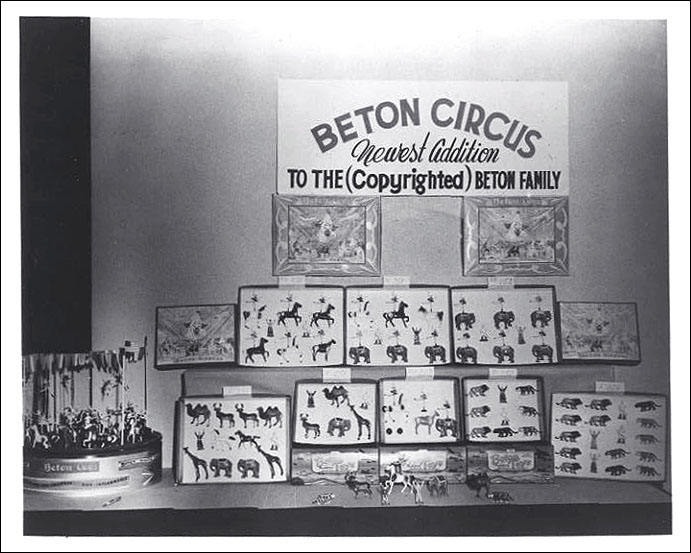
This Beton Archives photo shows eight of the 11 Circus sets and includes, left to right beginning in the top row, #MZ-350 Assorted Circus Horses and Riders, #MZ-351 Assorted Mounted Circus Performers on Horses and Elephants, #MZ-352 Assorted Mounted Circus Performers on Elephants (this set is not represented in O’Brien’sToy Soldiers books), #Z-353 Assorted Large Circus Animals and Figures, #Z-251 Assorted Large Circus Animals and Figures, #MZ-252 Assorted Circus Horses, Elephant, and Riders, #Z-250 Assorted Small Circus Animals and Figures, and #Z-354 Assorted Small Circus Animals and Figures.
Assorted Small Circus Animals & Figures, Set #Z-250
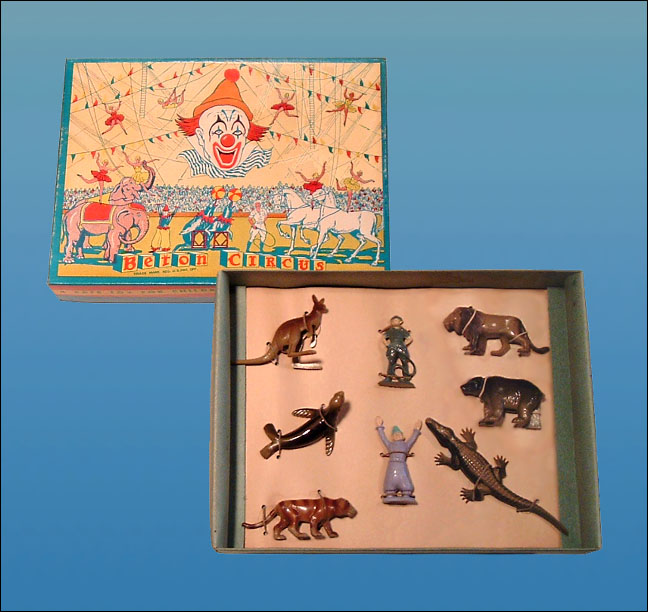
I had never given much thought to the contents of the smaller-sized circus sets until I wrote this article. Although the contents of this pictured set #Z-250 are typical, it defies the title description by including the alligator. According to the 1955 Beton catalogue, the alligator is listed as a Large Circus Animal. Even more surprising is that the catalogue illustration of set #Z-250 also shows the alligator. The #Z-250 set shown in the Beton Archives photo above contains only small animals, but includes one more animal than is shown in my set or in the catalogue.
Assorted Large Circus Animals & Figures, Set #Z-251
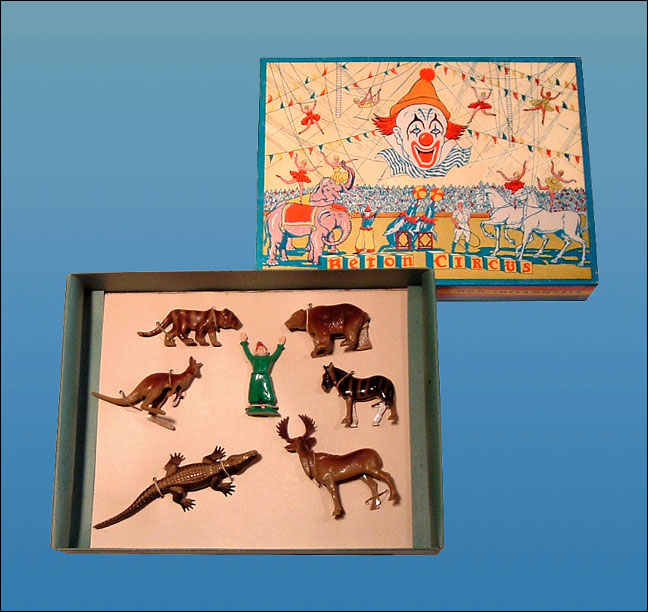
This set’s contents depart even further from the catalogue’s title description. Only two of the animals, the alligator and the moose, are listed in the 1955 catalogue as large animals. The other four are listed as Small Circus Animals. The catalogue illustration for set #Z-251 also shows this typical configuration, but the Archives photo above shows only four large animals and two figures.
Large Circus Animals, Set #Z-353
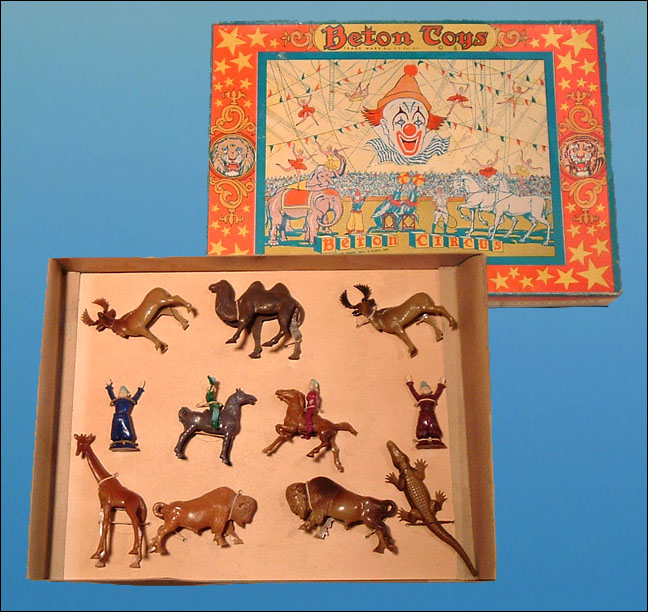
All of the references that I have for Set #Z-353 come very close to agreeing on the contents, and they all contain large animals. Although different large animals are used, my photo and the 1955 Beton catalogue are alike. The Archives photo above departs slightly from this by eliminating the two small riders.
Farm Sets
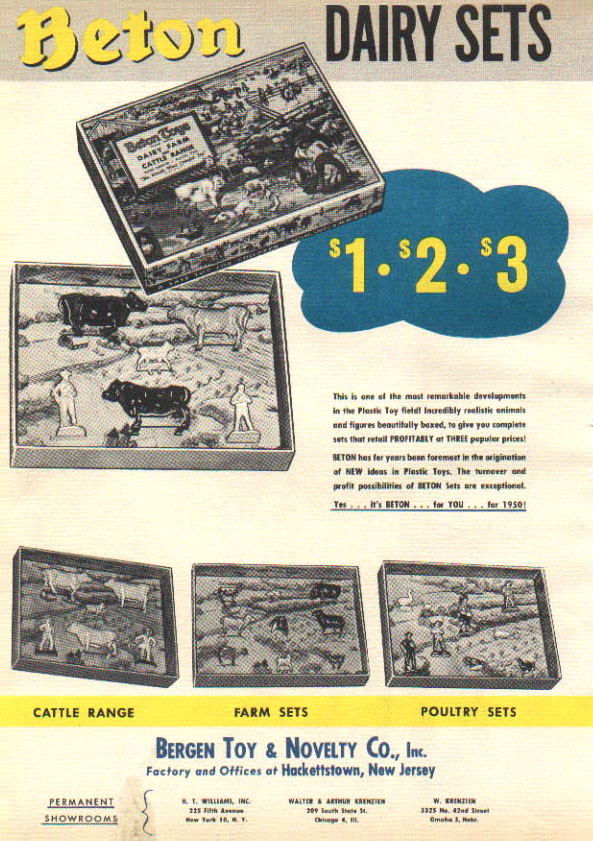
This March 1950 Playthings magazine advertising insert shows that Beton produced three farm sets, plus a Cattle Range set. By 1955, this Range set was given catalogue number 181, and renamed Cattle Ranch. The Cattle Ranch and Dairy Farm sets are also depicted in the J. J. Newberry window display photo above. The only difference between the two sets is that the Ranch holds two cowboys instead of two farmers, however, I’ve found that on my set, two cowboys will not fit into the brackets provided for the farmers. Evidently, two separate inserts were used in these sets.
All three of the Farm sets seem to have two different configurations. Two of these differences show up in this 1950 Playthings magazine insert, and also in the circa-1955 Beton catalogue mentioned earlier.
Dairy Farm, Set #171
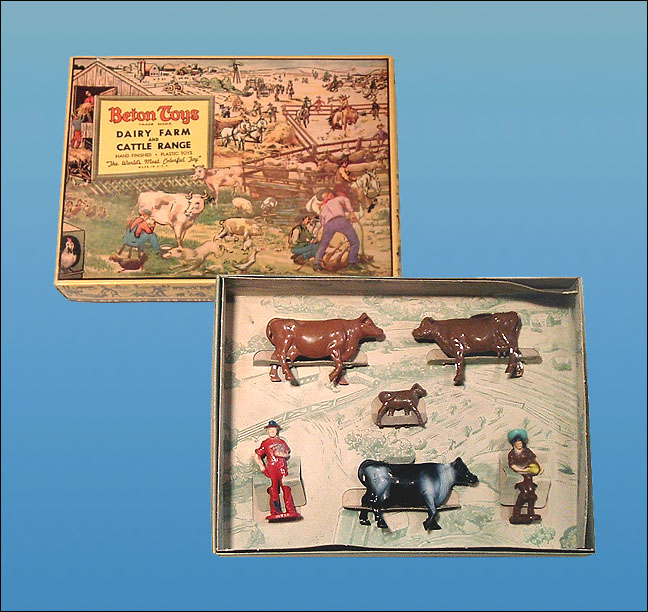
This set went through two configurations. My set that I’ve pictured here is the same as the one illustrated in both the 1950 Playthings insert and Beton’s circa-1955 catalogue.
Dairy Farm, Alternate Set #171
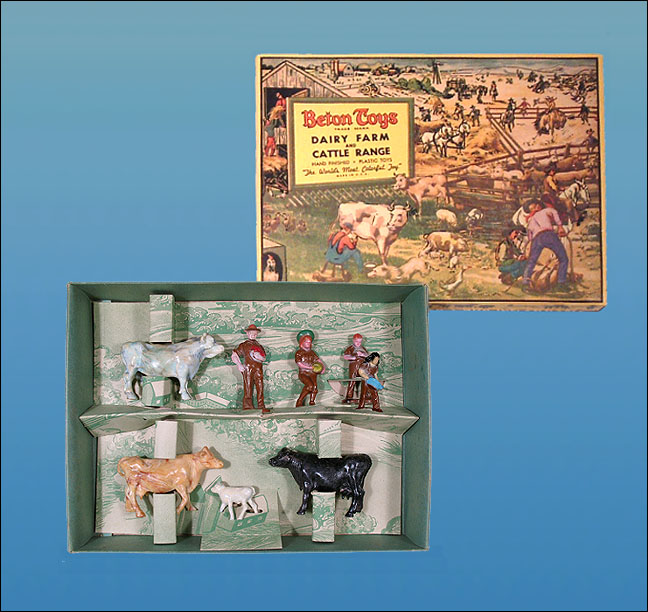
Ponylope has acquired this different Dairy set #171, that, when received, contained a bull, two cows, a calf, a rooster, a hen, a chick, and a farm girl. The insert in this set is completely different, and three of the slots seem to be designed to hold the other three farm figures, instead of the inappropriate poultry pieces. This alternate set has been pictured as I believe it was originally produced. I’ve yet to find this configuration in a Beton catalogue or advertising piece, so I’m unable to verify this speculation.
Assorted Farm Animals, Set #191
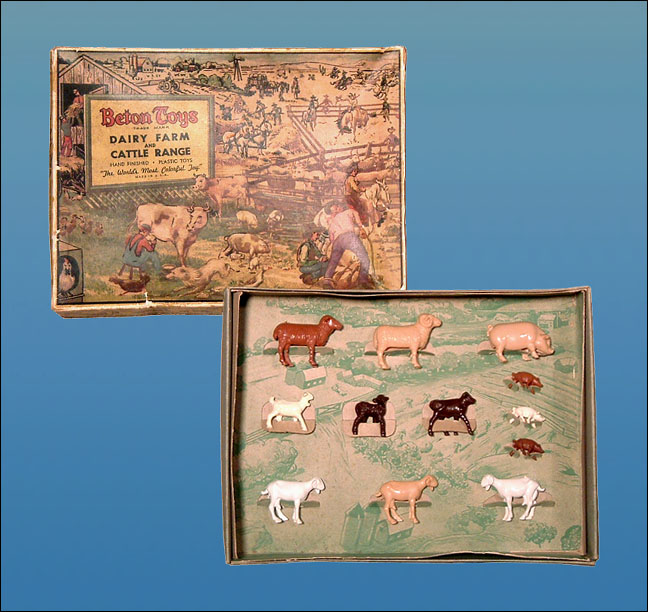
In the 1950 Playthings magazine insert above, this set’s illustration shows the larger assorted farm animals only. Although Beton’s pigs were first produced on September 1, 1949, they were not included as part of this assortment. The circa-1955 catalogue illustration does include box insert slots for three pigs, and this second configuration is shown in my photograph.
Assorted Farm Figures and Poultry, Set #261
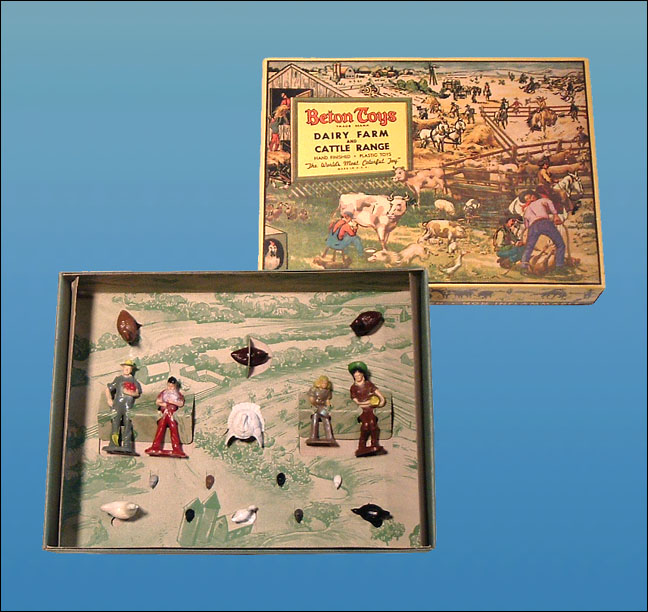
Like the above sets, this box also contained two different configurations. The same 1950 Playthings insert shows the figures arranged in the box in diagonal rows and includes one duckling only. The 1955 catalogue illustrates the figures set in horizontal rows and includes three chicks and three ducklings. The set shown is from circa-1955.
Large Rider Sets

This photo from the Beton Archives shows eight of the 14 M-300 series Large Rider Sets. Shown counterclockwise from top left are #M-310 Assorted Indians (this set is not represented in O’Brien’sToy Soldiers books), #M-380 Assorted Riders, #M-300 Lady & Gentleman Hunters, #M-301 Cowboy, #M-307 Cowgirl, #M-309 Polo Player, #M-303 Cadet - U.S. Cavalry Officer, and #M-306 Cowboy & Cowgirl. #M-300 through #M-310 and #M-380 each contain six large mounted riders, along with two standing figures. Sets #M-382 & #M-383 are the only sets in the M-300 series that contain any figures other than Large Riders.
Small Rider Set
Assorted Small Horses - Extra Rider & Footmen, Set #M-383
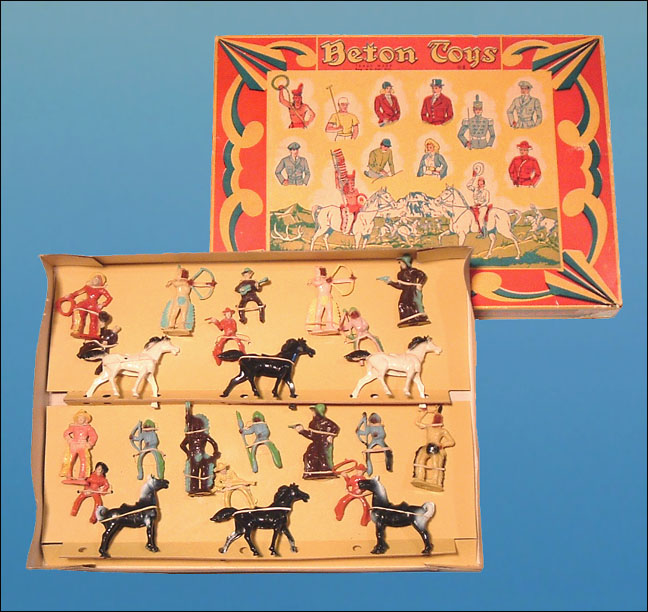
This is the only large Beton boxed set in the M-300 series that contains all small mounted riders.
Handling Boxes
According to the circa-1955 catalogue, Bergen Toy & Novelty’s designation for their wholesale shipping boxes was “Handling Boxes.” These came in two sizes, depending upon the size of the figures, plus the one dozen or two dozen figures that the boxes would contain. The top of the J. J. Newberry window display photo above shows the catalogue numbers for the Small Riders and standing figures, while the photo of the Large Riders above shows their catalogue numbers. All catalogue numbers were hand-stamped on the ends of the Handling Boxes.
Firemen & Policemen Assorted, Catalogue #581
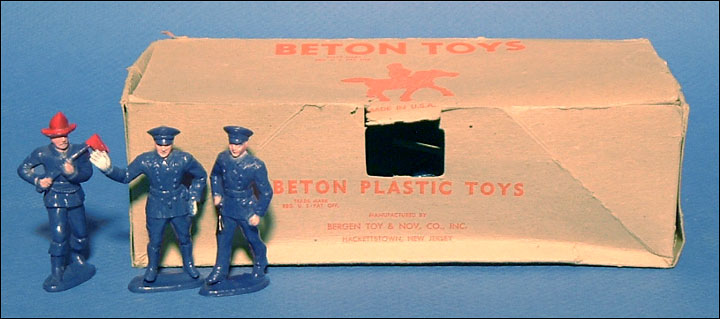
Lady Performer On Elephant Assorted, Catalogue #ZC-101
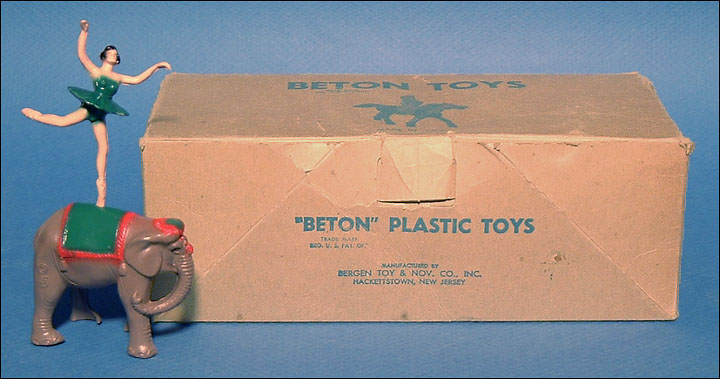
Header Bags
It is uncertain when Bergen Toy & Novelty Co. first began packaging their products in Header Bags, but it was most likely around 1955-1956. The smaller “Lifelike Plastic Toys” bags evidently were the first produced, because they seem to always show up with painted figures. The larger “Lifelike Toys” bags, on the other hand, seem always to contain sets of unpainted soft plastic figures from the 1957-1958 period.
Lifelike Plastic Toys Header Bags
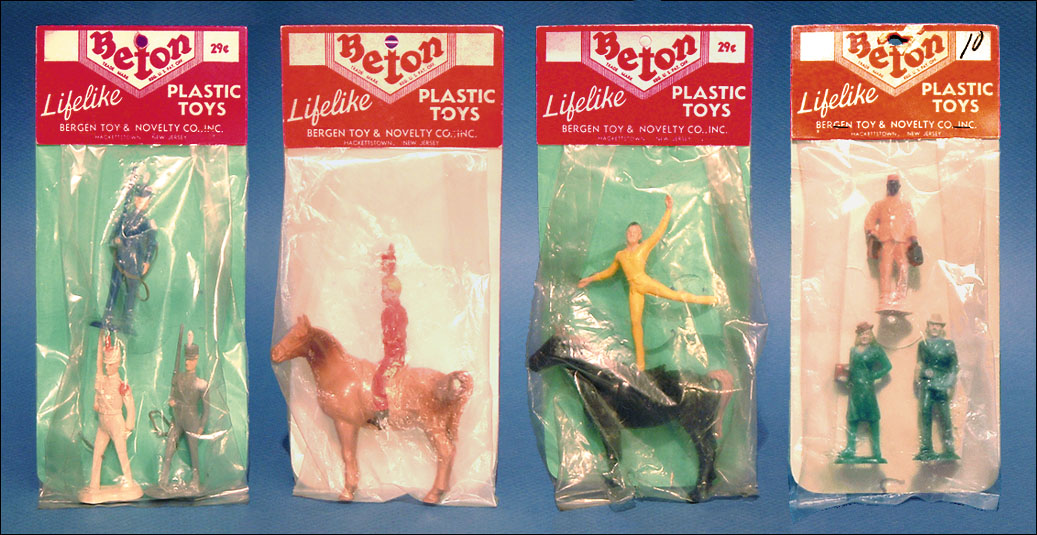
This type of bag has a listing of other available bagged items on the backs of the header cards. Two of the bagged sets shown are #B-1 Large Horse & Cowboy Rider and #B-25 Civilian Figurines, and they list only 15 available sets (B-1 through B-20). The other two sets are #B-17 Gentleman Performer On Horse and #B-27 Cadet Figurines, and they list 22 available sets. In both cases there are five missing set numbers: B-3, and B-5 through B-8.
Lifelike Toys & Infantry Toys Header Bags
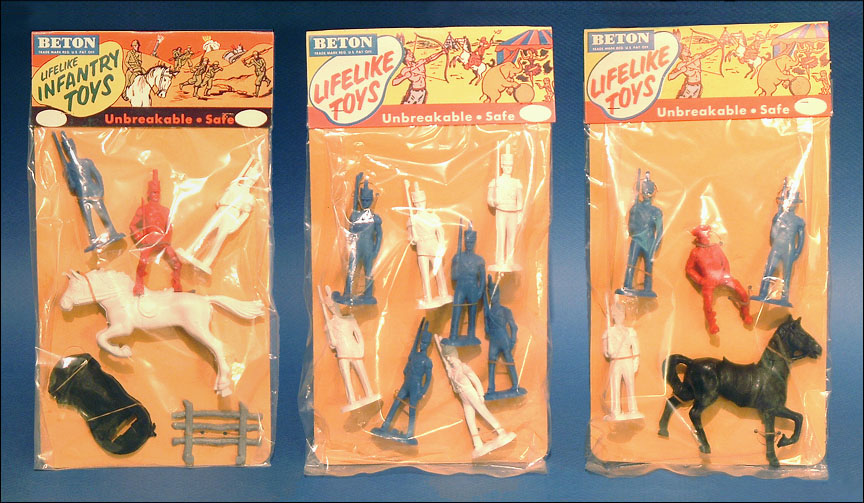
These larger bags were probably very short lived, as the only ones that consistently show up are the three soft plastic sets shown. Since these three sets are all military, you would expect them to be packaged in the “Lifelike Infantry Toys” header only. The header depicting Indians, cowboys and circus figures seems like it should contain only non-military sets. Neither of these two header cards lists other available sets on the back.
Non-Beton Header Bags
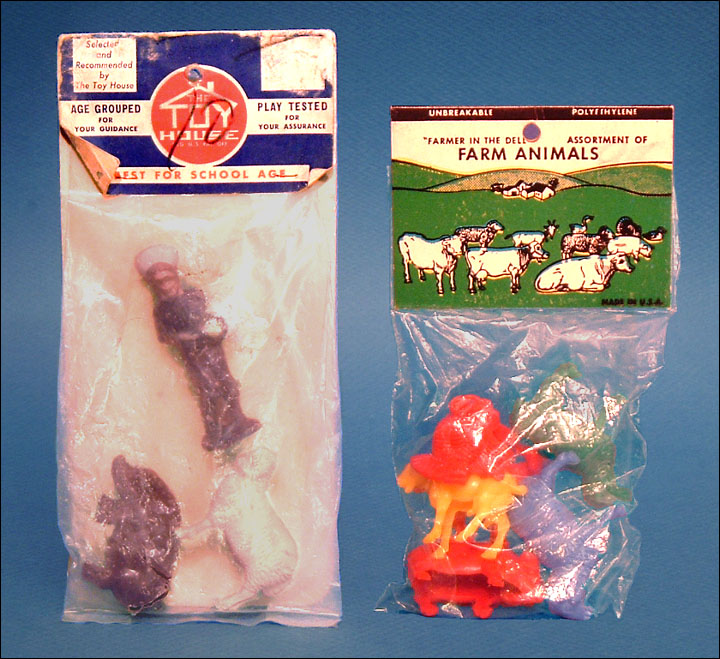
The two bags shown contain Beton figures in packages from other companies. I have no idea what contractual arrangements these companies may have had with Bergen Toy & Novelty Co., but on the back of The Toy House header it explains how World Toy House, Inc., of Saint Paul, Minnesota, play-tests and recommends toys from all parts of the United States. Evidently they did not manufacture any of the products contained in their packages.
Soft Plastic Boxed Sets
During the last couple of years before Bergen Toy & Novelty Co. closed its doors in 1958, production turned to brightly colored, unpainted soft plastic figures. Beton also redesigned some of their packaging to compete with several other plastics competitors’ display boxes. The catalogue numbers stamped on the soft plastic sets that I’ve been able to acquire are all prefaced with a handwritten “N”.
Indians - Cowboys, Set #NM-311
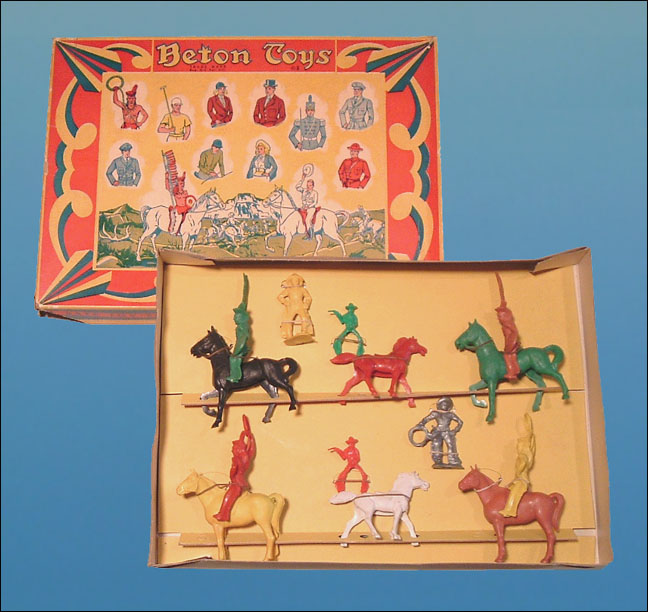
This set utilized the earlier box used for Large Rider sets, and continued the M-300 series with an additional new #M-311.
Cowboys & Indians - Assorted (foot and mounted), Set #N-120
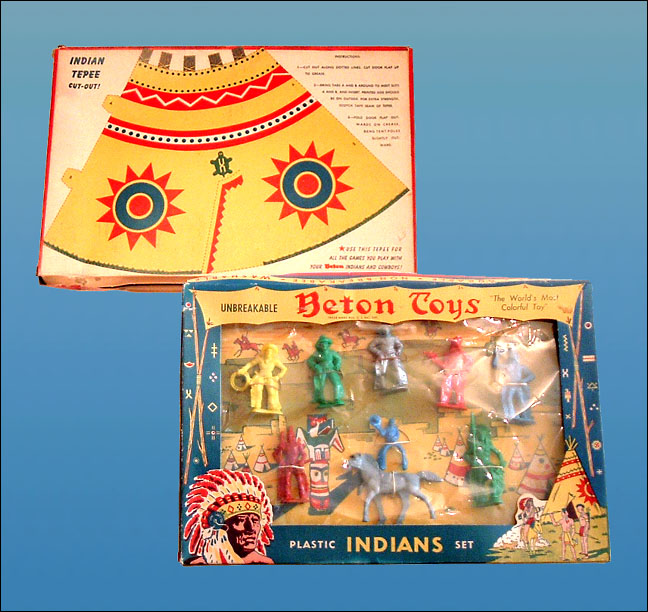
Beton followed their original, late-1930s catalogue number for this display set. The box design is reminiscent of both Ajax and Lido display boxes. These two companies were competitors who copied several of Beton’s Small Riders and packaged them in boxes with appropriate cut-outs on the back. Beton also packaged this set with an attractive Indian Tepee cut-out.
Mounted Cowboy & Indian Assorted Horses. Set #NM-214
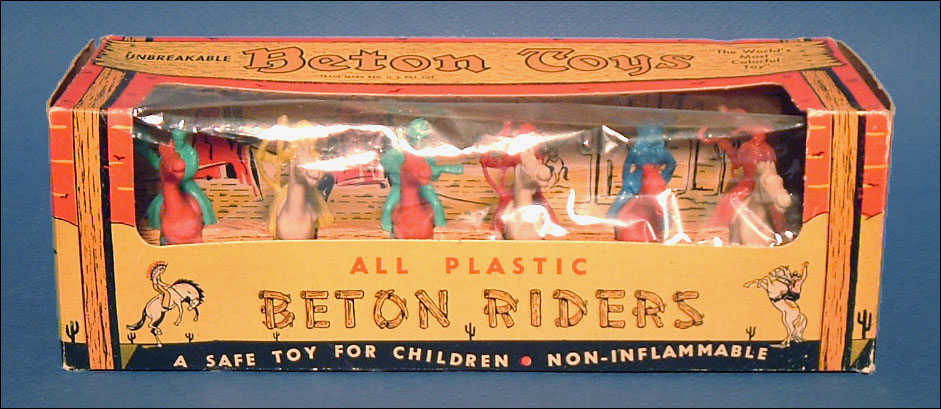
Beton also made use of their original catalogue numbering system for this late-1950s-designed display box.
I hope that other Beton collectors have benefited from the information that I’ve presented here.
Plus, I hope you’ve enjoyed the article as much as I’ve enjoyed putting it together.
Copyright 2008, 2009 Ron Steiner
Vintage Toy Horses and Plastic Playset Miscellany from the 1950s On . . .
|










































